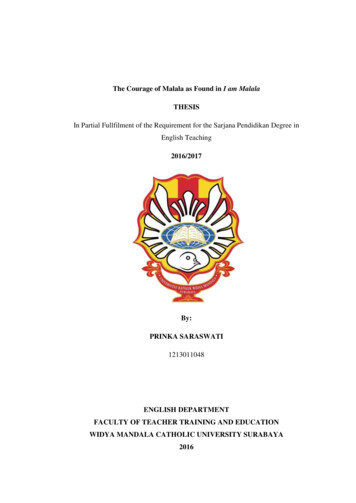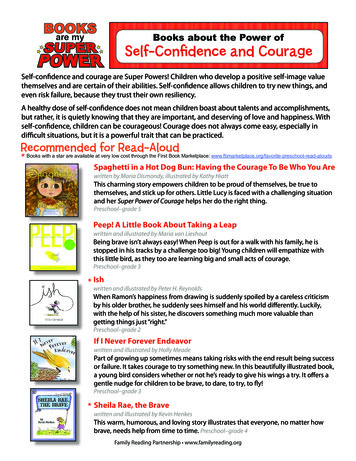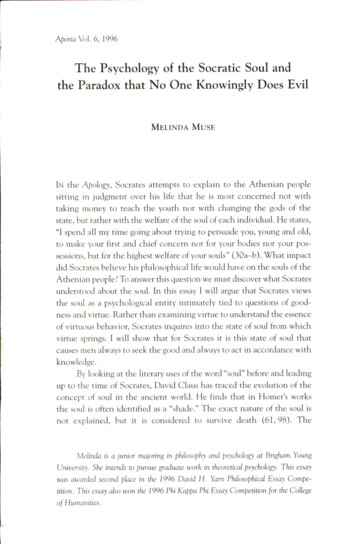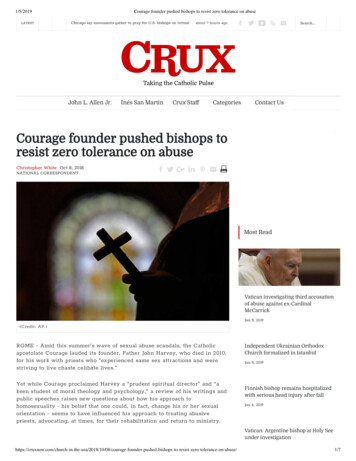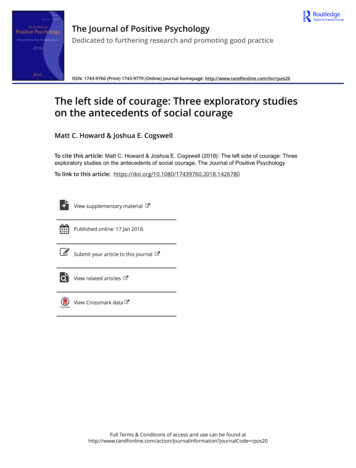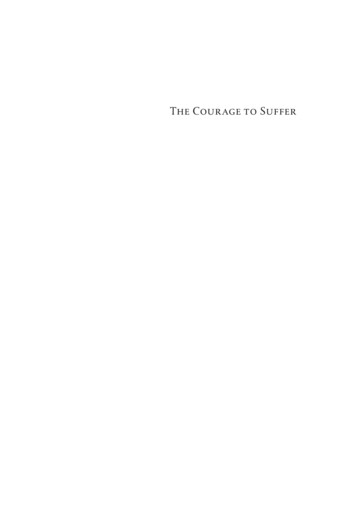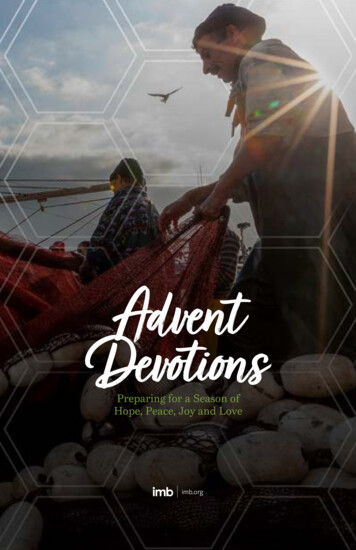
Transcription
VISTAS OnlineVISTAS Online is an innovative publication produced for the AmericanCounseling Association by Dr. Garry R. Walz and Dr. Jeanne C. Bleuerof Counseling Outfitters, LLC. Its purpose is to provide a means ofcapturing the ideas, information and experiences generated by theannual ACA Conference and selected ACA Division Conferences. Paperson a program or practice that has been validated through research orexperience may also be submitted. This digital collection of peer-reviewedarticles is authored by counselors, for counselors. VISTAS Online containsthe full text of over 500 proprietary counseling articles published from2004 to present.VISTAS articles and ACA Digests are located in the ACAOnline Library. To access the ACA Online Library, go tohttp://www.counseling.org/ and scroll down to the LIBRARYtab on the left of the homepage.nUnder the Start Your Search Now box, you may searchby author, title and key words.nThe ACA Online Library is a member’s only benefit.You can join today via the web: counseling.org and viathe phone: 800-347-6647 x222.Vistas is commissioned by and is property of the American CounselingAssociation, 5999 Stevenson Avenue, Alexandria,VA 22304. No part of Vistas may be reproduced without expresspermission of the American Counseling Association.All rights reserved.Join ACA at: http://www.counseling.org/
Suggested APA style reference:Blagen, M. T., & Yang, J. R. (2008, March). Courage and hope as factors for clientchange: Important cultural implications and spiritual considerations. Based on aprogram presented at the ACA Annual Conference & Exhibition, Honolulu, HI.Retrieved June 27, 2008, from agen.htmCourage and Hope as Factors for ClientChange: Important Cultural Implicationsand Spiritual ConsiderationsMark BlagenAdams State CollegeJulia YangGovernors State UniversityBlagen, Mark, T., Ph.D., CAC, is an Associate Professor of Counselor Education atAdams State College. Dr. Blagen has been a Certified Addictions Counselor since 1990and has taught addictions courses since 1992. His primary research interests includedefining the spiritual dimensions of addiction recovery, understanding the therapeuticfactors of 12-step recovery, understanding the nature of natural recovery, andinvestigating the relationship of purpose in life and the use of alcohol and other drugs.Yang, Julia, Ph.D. is a University Professor of Counseling at Governors State University.Dr. Yang was an elementary school teacher and counselor, high school career explorationspecialist, and vocational rehabilitation counselor prior to her career in counseloreducation. Her research and practice has focused on identifying and counseling at riskadolescents and understanding the concept of courage from an Adlerian psychologyperspective.Based on a program presented at the ACA Annual Conference & Exhibition, March 2630, 2008, Honolulu, HI.
Clients often enter counseling in a state of despair. Restoring courage and hope is animportant aspect of facilitating client change. As a counselor it is imperative that weunderstand each client as an individual who will decipher the nature of courage and hopebased on their own unique belief system. This belief system is influenced by theirreligion and spirituality, ethnicity and other multicultural influences.In the recent development of positive psychology and in the integration of spirituality andpsychology, courage and hope, along with other characteristics, are discussed as virtues, astate of mind, attitudes, emotions, strengths, or actions. In this article the authors presentcourage and hope as psychological constructs, cultural values, as well as spiritual gifts.This article concludes with practical implications of how counselors may engage theclient in developing the characteristics of courage and hope.CourageWithin the framework of positive psychology courage is defined as “Emotional strengthsthat involve the exercise of will to accomplish goals in the face of opposition, external orinternal” (Dahlsgaard, Peterson, and Seligman, 2005, p.205). Courage, a moral virtue, isalso defined by the character strengths of bravery, perseverance, authenticity, integrity,and vitality. Oddly, the authors of positive psychology have found that courage ismissing, either explicitly or thematically implied, in the eastern traditions ofConfucianism, Taoism, and Buddhism. Courage has a different meaning and ismanifested as an integral aspect in these traditions. As discussed in a later section of thisarticle, courage is located at the core of these traditions, and yet is still an action andwillful strength.To see courage as willfulness, we need to have an understanding of the concept of thewill to power both within the existential and Adlerian psychology frameworks. Based onNietzsche’s concept of the will to power, Tillich (1980) described courage as “ thepower of life to affirm itself in spite of this ambiguity ” (p.27). To Tillich, courage hasa revealing power via our participation and individuation. To Adler, the will to power is aprocess of creative energy desiring to exert one’s will in self-overcoming and interactionwith the world. It leads us to either normal self-enhancement in the interest of others, orendless striving for perfection, the fictional goal of superiority. Influenced by Tillich andAdler, May, R. (1983) suggested that the concept of will to power implies ‘selfactualization’, as an expansion of one’s self. “Courage is not the absence of despair; it israther, the capacity to move ahead in spite of despair” (May, R. 1975, p.3).Adler put this willingness to act into a social context (i.e. community feeling), “But onlythe activity of an individual, who plays the game, cooperates and shares in life can bedesignated as courageous.” (in Ansbacher and Ansbacher , 1973, p.60). To Adlerians,problems of social living are all about “the relationship of the individual to the problemsof the outside world” (Adler in Ansbacher and Ansbacher, 1956, p.205). Our fear of not
making it or not belonging is heightened when we encounter the world around us, theworld with us, and the world within us (May, R. 1983). We must have courage to meetthe demands of work, love, and friendship, which are the three life tasks of social livingpostulated by Adler.HopeWithin the framework of positive psychology hope is described in the following manner,“Hope, optimism, and future-mindedness are a family of strengths that represent apositive stance toward the future” (Seligman, 2002, pp.156-157). Other definitions andconstructs of hope include the concept that hope can only exist in the face of despair as away of coping (Godfrey, 1987), or that hope is a concept that allows an individualmovement toward a goal (Erikson, 1964), and that hope is a way of thinking andbelieving that is goal directed that produces routes to desired goals with the motivation touse those routes (Snyder, 1994).As can be seen from the above definitions, hope is both a cognition and an emotion.Having a sense of hope is in the affective domain, and yet acting on the hope requiresmotivation and a plan that is actively carried out.As we consider the above definitions and think of what does hope mean to clients whohave gone through devastating losses, it is easy to conclude that some clients possess ahigh degree of the affective domain of hope but an inability to take action, while otherclients seem to possess neither a sense of hope nor the motivation to move forward in ahopeful way. What can a counselor do? A starting point is considering hope from a morecomprehensive vantage point.May, G. (1988) states that even in the most despairing of times each of us possess thepower of choice and “We may go through a great deal of humbling, if not outrighthumiliation, before we come to this simplicity of hope” (p. 19). So in the tradition ofVictor Frankl, Rollo May, and Carl Rogers, Gerald May suggests in the above quote, thathope is a choice and the more dire the circumstance the more likely an individual willmake a choice to hope. As the last section of this paper concludes, there are many thingscounselors can do to encourage hope and to develop the motivation to be activelyhopeful.Courage and Hope in Cultural and Spiritual ContextFrom the positive psychology perspective, knowing our signature strengths and usingthose strengths in our relationships and in service of others is to acquire a good life and todiscover the meaning of life which constitute two out of three paths to authentichappiness (Seligman, 2002). The authors would like to advocate that a critical task for acounselor is to understand the strengths of the client in respect to the client’s cultural andspiritual background. This means understanding as fully as possible the individual’s
adherence to the values prescribed by his/her cultural heritage and spiritual traditions. Forexample, family systems from east and southeast Asia tend to “hold-in” their toleranceand demonstrate a “quiet” and accepting resiliency to unpredictable life changes,hardship, disasters, and unhappiness they experience. Is that not a demonstration ofcourage and hope? From a cultural standpoint it is. Additionally, it is important tounderstand that many beliefs in the Christian tradition provide answers to the quest forcourage and hope that are very similar eastern tradition core values.For thousands of years, Confucianism, Taoism and Buddhism complemented one anotherin their far reaching cultural influence in China and the neighboring countries. Similar tothe Adlerian concept of community feeling, Confucius’ teaching of courage and hopeshares the practical wisdom with a focus on moral quality that portrays the idealindividual ethical behaviors for his/her society. Taken from the French root of courage,Coeur, courage is a heart matter (May, R. 1975). The Chinese expression of courage isrelated to Chi, a spirit or a form of energy, transcending the emotional and intellectualexperiences. Courage, a mature virtue, is preceded by compassion and wisdom.According to Lin (1937, 1998), wisdom, led by the passion (soul of life), leads to courageby rejecting the worldly values of wealth and power. Such discernment is based on anintegrity in knowledge.Embedded in the animistic world view, hope is seldom a word used in the classic Chinesetext. Instead, perseverance and persistence are often the signs of will power in Chinesemoral teaching and attainment of harmony is best achieved with the attitudes ofnaturalness, a strong work ethic, solitude, acceptance, and contentment. These thoughtsare similar to the Rogerian view of quiet power (Eckstein and Cooke, 2005) and theTaoist view of soft courage by which the individual develops character by acting inharmony with The Way, the ultimate resource of all things. Embracing simplicity,patience and compassion as life's greatest treasures is the closest the Taoist masters cometo outlining a moral or ethical code.The theme of perseverance and patience of the soft courage in Chinese culture is clearlyshared in the Christian virtues of faith, love, and hope. Hope implies waiting andstillness. Hope and courage are both spiritual gifts in Christian tradition. Hope andcourage can produce endurance and encouragement for the individuals in the face of fearand despair. To conquer fear, courage becomes an expression of faith (Tillich, 1980). It iswhen we are most vulnerable and powerless we are given the most profoundopportunities to risk believing that we are born in love, of love, and for love. The courageof faith allows the natural life force such as grace to do its work: Grace brings us hope asa manifestation of God’s most supreme love (May, G. 1988).Engaging the Client in the Change ProcessWhat facilitates client change? Although the answer to this question is at the root of mostcounseling theories, counseling has yet to find a clear answer to this question. In this
section, the authors wish to present two case vignettes that illustrate the techniques ofencouragement and motivational interviewing that assist the client in recovering courageand hope.Adlerian psychology has the potential for bringing us to an optimal level of functioningfor the life tasks of work, love, and friendship by use of encouragement. As a technique,encouragement can be used to motivate change and improve behavior. When definedusing the root meaning of courage, encouragement is, “the process of facilitating thedevelopment of a person’s inner resources and courage toward positive movement”(Dinkmeyer and Losoncy in Cheston, 2006). The following case illustrates the use ofearly recollection techniques in a dialogue that allowed the interviewer to develop insightabout the interviewee’s courage in helpless situations.Case #1Rodney was an 8 th grader attending an alternative school after being expelled from hisschool due to drug selling and bullying behaviors. He was referred to counseling after arecent confrontation with his step father who pointed a gun at his mother. Rodneyreported the situation to the school. As a result, the step father was arrested. In a groupcounseling session, Rodney was invited to share with others his recollections while thegroup helped identify his strengths. The group was asked to listen and record strengthsand assets. The group encouraged Rodney to use his strengths to avoid bullying andbeing bullied after school.RecollectionsStrengthsShare more about your self using any two ofthe following: Early memories, family story,childhood changes, a news headline, day/nightdreams. Brave Willingness toprotect others“I caught a snake in my backyard. I was veryyoung and I was afraid. My mother was fearful.Well, I had to do it.” Although feelingafraid, still go ondoing what isnecessary Independent Caring Honest CreativeA Headline story: “Another Black MaleEscaped from the County Jail.”Is there a situation now you might use yourstrengths to meet a challenge?“On my way home after school, there are guyswaiting for me out there. I used my fist lasttime. They deserved that. You know, I am pretty
big.”Two weeks later.“Guess what? I got a skateboard. I will use itfinding another way home.”As the above illustrates, encouragement is a natural way to assist a client in findingcourage in times of despair. Another method in humanistic psychology, motivationalinterviewing, can also be very useful in encouraging a client’s sense of hope. Miller(2000) stated that, in addition to Rogers’ three critical conditions of acceptance,genuineness, and unconditional regard, other attributes such as patience and hope werealso critical in facilitating client change.To facilitate hope, counselors must demonstrate or model hope. In addition to beinghopeful, a counselor should also facilitate client change by “locating” and enhancing theexisting desire to be hopeful that most clients already possess. An example of this mightbe an alcoholic who has lost all hope of ever not drinking. By assisting the client inlocating a reason for not drinking and allowing the client to “hold” the conflicting views,it becomes natural, through a process of encouragement, for the client to increase theirdesire to not drink. Once that desire exists, the counselor can assist the client inunderstanding how best to enact the change. Hope is ignited in the client and reinforcedby the counselor. This is the basis of Motivational Interviewing which is both as hopefulas it is pragmatic. This approach has been shown to be effective for great varieties ofclient problems which includes such issues as anxiety (Slagle and Gary, 2007),depression (Swartz, Zuckoff, and Grote, 2007), and obesity treatment (Careles, Darby,and Cacciapaglia, 2007) to name but a few.Obviously client change does not come easy. Facilitating hope in and of itself creates theopportunity for client change. For that opportunity to be realized, it requires patience byboth the counselor and the client. One helpful model for understanding client change (andproviding the opportunity to model patience) is the Stages of Change model developed byProchaska and DiClemente (1982). This model allows the counselor to assess properlywhere the client is in the change process, meet the client at that place and provideinterventions that encourages the client to make incremental changes. By makingincremental change, the client can see tangible results and will begin to gain hope and themotivation to take the necessary steps to facilitate further change.Case #2James is a 29 year-old who is having difficulty “finding himself”. James feels as thoughlife is passing him by. James was raised in an Asian Caucasian bi-cultural home whichhas contributed to his difficulty with identity. He states that existing in two worlds isimpossible, but belonging to either does not seem to be an option. To quiet the anxiety of
this existence, James has used marijuana off and on for over 10 years. James is intelligentand when motivated, a very hard worker; but his most significant achievement to thispoint has mostly been to evade and avoide responsibility. James seems stuck with littleability to demonstrate courage or hope.After a session of building rapport and understanding cultural influences that areimportant to James, the counselor asks James to write a paragraph or two that describeswhat living a life that matters means to him. James was able to articulate that honoringboth aspects of his cultural heritage (thus honoring his family) mattered greatly to himalong with finding a place that he belonged. The counselor then asked James to identifythree achievable short-term (obtainable within one-year), middle-term (obtainable withinfive-years), and long-term (obtainable within his lifetime) goals. This activity is thebeginning of “locating” what hope resides in James so that the counselor can encouragehim to bring his the overall life ideal to progressively manageable goals. In addition, thecounselor uses reflection of meaning and positive asset search skills (Ivey, 2006) so thatboth the counselor and the client will have much to work on in the following sessions thatwill assist James in becoming more willful, thus connecting him to the emerging courageand hope that he possesses.ConclusionWe live in a troubled world and we often work with individuals who struggle formeaning and spiritual direction. A primary goal of counseling is to creatively facilitatehealthy changes that bring about courage and hope. The authors attempted to examinecourage and hope not only as universal virtues as indicated in positive psychology butalso as cultural values and spiritual gifts. An understanding of the client adherence tocourage and hope as defined in his/her cultural and spiritual heritage allow us to betteruse these constructs to assist the client in times of adversity and difficulties.ReferencesAnsbacher, H. L., & Ansbacker, R. R. (1956). The Individual Psychology of Alfred Adler.New York: Harper & Row.Ansbacher, H. L., & Ansbacher, R. R. (1973). Superiority and Social Interest (3 rd ed.).New York: Viking Press.Careles, R.A., Darby, L. & Cacciapaglia, H.M. (2007). Using motivational interviewingas a supplement to obesity treatment: A stepped-care approach. Health Psychology, 26,369-374.Cheston, S. E. (2000). Spirituality of encouragement. The Journal of IndividualPsychology, 56(3), 296-304.
Dahlsgaard, K., Peterson, C., & Seligman, M. E.P. (2005). Sacred virtue: Theconvergence of valued human strengths across culture and history. Review of GeneralPsychology, 9(3), 203-213.Eckstein, D. & Cooke, P. (2005). The seven methods of encouragement for couples. TheFamily Journal: Counseling and Therapy for couples and Families, 13(3), 32-350.Erikson, E.H. (1964). Insight and responsibility. New York: W.W. Norton.Godfrey, J.J. (1987). A philosophy of human hope. Dordrecht, Germany: MartinusNijhoff.Ivey, A.E., & Ivey, M.B. (2007). Intentional interviewing and counseling: Facilitatingclient development in a multicultural society (6 th ed.). Pacific Grove, CA: Brooks/ColeLin, Y. (1937, 1998). The importance of living. NY: William Morrow.May, G. G. (1988). Addiction and grace: Love and spirituality in the healing ofaddictions. San Francisco: Harper.May, R. (1983). The discovery of being. New York: Norton.May R. (1975). The courage to create. New York: Norton.Miller, W.R. (2000). Rediscovering fire: Small interventions, large effects. Psychology ofAddictive Behaviors, 14, 6-18.Prochaska, J.O. & DiClemente (1982). Transtheoretical therapy: Toward a moreintegrative model of change. Psychotherapy: Theory, Research, and Practice, 19, 276288.Seligman, M.E.P. (2002). Authentic happiness: Using the new positive psychology torealize your potential for lasting fulfillment. New York: Free PressSlagle, D.M. & Gary, M.J. (2007). The utility of motivational interviewing as an adjunctto exposure therapy in the treatment of anxiety disorders. Professional Psychology:Research and Practice, 38, 329-337.Snyder, C. R. (1994). The psychology of hope: You can get there from here. New York:Free Press.Swartz, H.A., Zuckoff, A. & Grote, N.K. (2007) Engaging depressed patients inpsychotherapy: Integrating techniques from motivation interviewing and ethnographicinterviewing to improve treatment participation. Psychology: Research and Practice, 38,
430-439.Tillich, P. (1980). The courage to be. New Haven, CT: Yale University Press.VISTAS 2008 OnlineAs an online only acceptance, this paper is presented as submitted by the author(s). Authorsbear responsibility for missing or incorrect information.
psychology, courage and hope, along with other characteristics, are discussed as virtues, a state of mind, attitudes, emotions, strengths, or actions. In this article the authors present courage and hope as psychological


